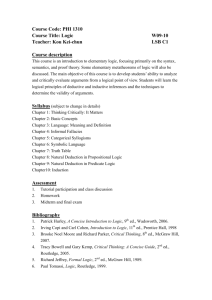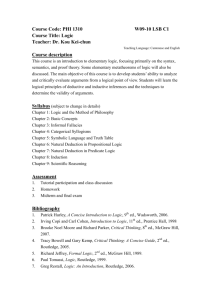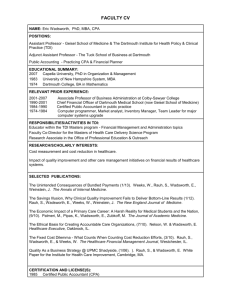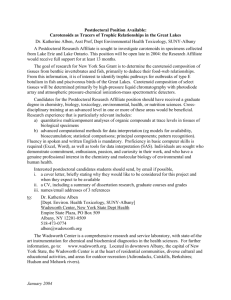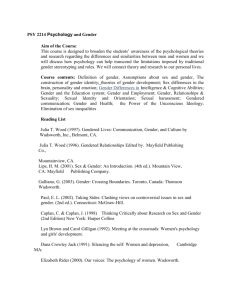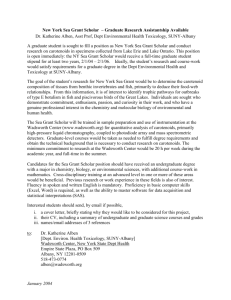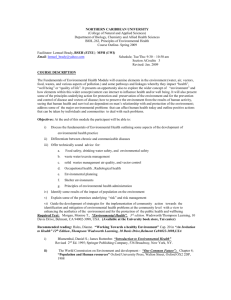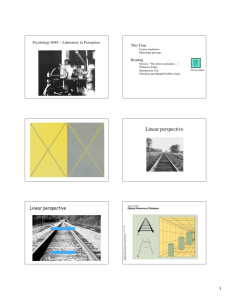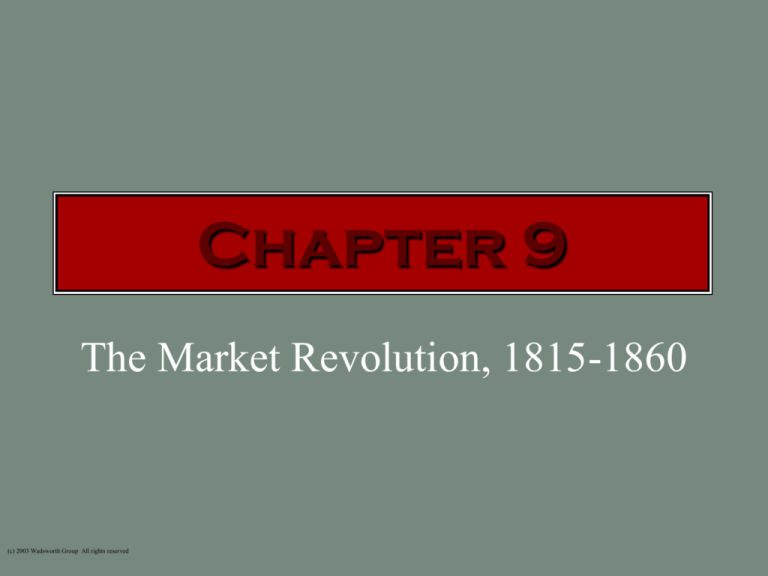
Chapter 9
The Market Revolution, 1815-1860
(c) 2003 Wadsworth Group All rights reserved
Government and Markets
• 14th Congress (1815)
– Chartered national bank
– Enacted a protective tariff
– Debated federally funded system of roads and
canals
• Many argued that national independence
would be achieved through subsidies to
commerce and manufactures
(c) 2003 Wadsworth Group All rights reserved
The American System:
The Bank of the United States
• Henry Clay
• Second Bank of the United States (1816)
(c) 2003 Wadsworth Group All rights reserved
The American System: Tariffs
and Internal Improvements
• Henry Clay and John C. Calhoun
– Tariff of 1816
– Internal Improvements
• Presidents Madison and James Monroe
oppose internal improvements
• State government and internal
improvements
– Erie Canal
(c) 2003 Wadsworth Group All rights reserved
Markets and the Law
• Courts prioritize legal principles desired by
merchant class
• John Marshall
– Dartmouth College v. Woodward (1816)
– McCulloch v. Maryland (1816)
– Gibbons v. Ogden (1824)
• State courts: right to develop property for business
purposes more important than neighborhood
wishes
(c) 2003 Wadsworth Group All rights reserved
The Transportation Revolution
• After 1815: dramatic improvements in
transportation:
–
–
–
–
Roads
Steamboats
Canals
Railroads
• Tied communities together
• Made a market society physically possible
(c) 2003 Wadsworth Group All rights reserved
Transportation in 1815
• Land transport very expensive compared to
water
• flatboats
• keelboats
– Mike Fink
(c) 2003 Wadsworth Group All rights reserved
Improvements:
Roads and Rivers
• Transportation revolution
• National Road
• Robert Fulton
– Clermont
(c) 2003 Wadsworth Group All rights reserved
Improvements: Canals and
Railroads
• Erie Canal
– DeWitt Clinton
– Model for canal boom across country
• Baltimore and Ohio Railroad
• New York Central
(c) 2003 Wadsworth Group All rights reserved
Time and Money
•
•
•
•
•
Freight costs went down
Speeds improved
Market revolution
Foreign trade continued to expand
Growing internal domestic market
(c) 2003 Wadsworth Group All rights reserved
Markets and Regions
• Market-driven economy: “market
revolution”
– Farmers trade their surpluses for urban products
• Until 1840 markets more regional than
national
• North becomes unified market in 1840s and
1850s
(c) 2003 Wadsworth Group All rights reserved
From Yeomen to Businessmen:
The Rural North and West
• Many young people of Northeast left for
cities and factory towns, or headed West
• Remaining generations began new forms
of agriculture
• Northwest was transformed from
wilderness into cash-producing farms
(c) 2003 Wadsworth Group All rights reserved
Shaping the Northern Landscape
• New England farmers could not compete with
western, frontier farmers
• Livestock raising replaced mixed farming for
many New Englanders – transformed the
woodlands into open pastures
• Factories and cities of Northeast provided Yankee
farmers a market for their meats and perishables
• More pasture, less cropland
(c) 2003 Wadsworth Group All rights reserved
The Transformation of
Rural Outwork
• Position of outworkers declines
• Manufacture began to concentrate in
factories
• Outworkers were reduced to dependence
on merchants, who began to control the
labor of outworkers
(c) 2003 Wadsworth Group All rights reserved
Farmers as Consumers
• New England farmers became customers for
necessities that they had once either produced or
acquired through barter
– Coal, cotton cloth, straw hats, shoes
• 1820s: storekeepers increased their stock in trade
by 45%
• Material standards of living rose
• Increased dependence on and vulnerability to
markets
(c) 2003 Wadsworth Group All rights reserved
The Northwest:
Southern Migrants
• Treaty of Greenville
• Americans migrated into Ohio, Indiana,
Illinois
• Southern born pioneers of the Northwest,
slavery blocked opportunities for whites
• Neighboring persists
(c) 2003 Wadsworth Group All rights reserved
The Northwest:
Northern Migrants
• 1830: northeasterners migrated to the
Northwest via the Erie Canal and on Great
Lakes steamboats
• Wisconsin and Michigan
• Immigrants from Germany and Scandinavia
• New settlers: receptive to improvements in
farming techniques and intensive
agriculture
(c) 2003 Wadsworth Group All rights reserved
Households
• 19th Century: Americans begin to limit the size of
their households
• Commercialization of agriculture closely
associated with the new concept of housework:
– Male work vs. female work
– New expectations of female tasks
• New notions of privacy, decency, domestic
comforts
• Emergence of separate kitchens and bedrooms
(c) 2003 Wadsworth Group All rights reserved
Neighborhoods:
The Landscape of Privacy
• Nature: a commodity to be altered and controlled
• Old practices and forms of neighboring
disappeared
• Storekeepers gradually demand cash, rather than
bartered goods
• Efficient farmers concentrated on commodities to
bring to market and purchases made for family
comforts
• Farmers increasingly dependent on outside world
(c) 2003 Wadsworth Group All rights reserved
The Industrial Revolution
• 1820-1870: American cities grew faster than
ever before or since
• Seaport cities gain more from commerce
with interior than overseas
• Beginnings of industry and the greatest
period of urban growth in U.S. history
(c) 2003 Wadsworth Group All rights reserved
Factory Towns:
The Rhode Island System
• Jeffersonians—factory towns are bad and
overcrowded with dependent masses
• Neo-Federalists: U.S. can make decentralized
factories
• Richard Arkwright
• Samuel Slater
– Rhode Island (or family) system
(c) 2003 Wadsworth Group All rights reserved
Factory Towns:
The Waltham System
• Francis Cabot Lowell and the Boston Associates
• Waltham System
– Process mechanized to minimize skilled labor
– Labor force primarily young farm women housed in
company boarding houses
– Wage labor gave women way out of rural patriarchy
(c) 2003 Wadsworth Group All rights reserved
Urban Businessmen
• Acceptance of urban class divisions:
– Seaport merchants and wealthy men of finance
– new middle class
– impoverished producers, laborers
• Commercial classes transformed the look and feel
of American cities
• Downtown business offices
• Main Street storefronts
• Shopping markets in Boston, Philadelphia,
Rochester
(c) 2003 Wadsworth Group All rights reserved
Metropolitan Industrialization
• Growth in amount of laborers who made
consumer goods
• Pre-1850s: few goods were made in
mechanized factories – most were made by
hand
• Urban working class
• Clothing and shoe manufacturing
– Men skilled labor, women unskilled
• Social distinctions between manual and
non-manual labor
(c) 2003 Wadsworth Group All rights reserved
The Market Revolution in the
South
• Cotton belt extended into Mississippi,
Texas, Arkansas, Alabama, Louisiana
• 1840s: cotton accounted for one-half to twothirds the value of all U.S. exports
• South produced three-fourths the world’s
cotton supply
(c) 2003 Wadsworth Group All rights reserved
The Organization of Slave Labor
• Many plantations produced only cotton
• Southern planters organized slave labor to
maximize production and reinforce
dominance of white farm owners
• Frederick Law Olmstead’s observations
• Association of labor with slaves shaped
Southern perceptions of dignity of work
(c) 2003 Wadsworth Group All rights reserved
Paternalism
• Post-1820: exploitation of slave labor
became more systematic and more humane
• Systematic paternalism
• Slaves’ material standards rose
– Physical height
– Infant mortality
• After 1808, imports of new Africans were
banned
(c) 2003 Wadsworth Group All rights reserved
Yeomen and Planters
• Cotton: economies of scale
– Big farms with many slaves operated more efficiently
and profitably than farms with fewer resources
– Wealth becomes more concentrated
– Dual economy
• Plantations at center
• White yeoman farmers at fringe
• Upcountry yeoman
– Traditional household and neighboring lifestyle
(c) 2003 Wadsworth Group All rights reserved
Yeomen and the Market
• Southern yeomen practiced mixed farming
for household subsistence and
neighborhood exchange
• System of “subsistence plus” agriculture:
market serves interests, but does not
dominate
• Entrepreneurship and ambition discouraged
(c) 2003 Wadsworth Group All rights reserved
A Balance Sheet: The Plantation
and Southern Development
• Wealth of South great, but concentrated
– Wealth disparity created political cleavage
– Wealth concentration stifled southern market
• Effect of Market Revolution on South: more
slavery
• Technology and development
– Eli Whitney and cotton gin
– Little spending on internal improvements
– Cities primarily export centers
• DeBow’s Review
(c) 2003 Wadsworth Group All rights reserved
Conclusion
• James H. Hammond: “Cotton is king”
• The South’s commitment to cotton and slavery:
– Politically isolated the South
– Made the South dependent on financial and industrial
centers
• North and West both enriched by Market
Revolution
– Northeast moves from periphery of world economy to
core
(c) 2003 Wadsworth Group All rights reserved

